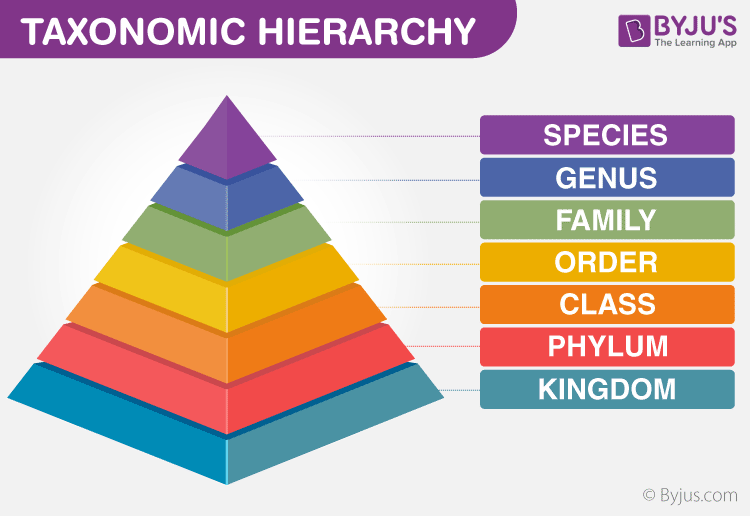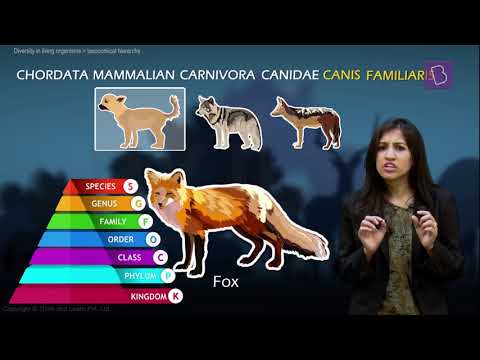According to the history of biological classification, Aristotle, a Greek philosopher classified different animals based on the habitat, characteristics, etc. Later, a Swedish botanist Carolus Linnaeus introduced Taxonomic Hierarchy Categories during the 18th Century, and this system of classification is followed globally till date.
Taxonomic hierarchy refers to the sequence of categories in increasing or decreasing order. Kingdom is the highest rank and species is the lowest rank in the hierarchy.
Let us have a detailed look at Taxonomic Hierarchy in Biological Classification.
What is Taxonomic Hierarchy?
The word “Taxonomy” is derived from a Greek word – “taxis”, meaning arrangement or division, and “nomos”, meaning method.
Taxonomy is a branch of Biology that refers to the process of classifying different living species. A taxon is referred to as a group of organisms classified as a unit.
“Taxonomic hierarchy is the process of arranging various organisms into successive levels of the biological classification either in a decreasing or an increasing order from kingdom to species and vice versa.”
Each of this level of the hierarchy is called the taxonomic category or rank.
In this system of classification, kingdom is always ranked the highest followed by division, class, order, family, genus, and species.
Also Read: Binomial Nomenclature

Taxonomic Hierarchy
Taxonomic Hierarchy Categories
Following are the important taxonomic hierarchies in which different organisms are classified:
Kingdom
The kingdom is the highest level of classification, which is divided into subgroups at various levels. There are 5 kingdoms in which the living organisms are classified, namely, Animalia, Plantae, Fungi, Protista, and Monera.
Phylum
This is the next level of classification and is more specific than the kingdom. There are 35 phyla in kingdom Animalia. For Example – Porifera, Chordata, Arthropoda, etc.
Class
Class was the most general rank in the taxonomic hierarchy until phyla were not introduced. Kingdom Animalia includes 108 classes including class mammalia, reptilia, aves, etc. However, the classes used today are different from those proposed by Linnaeus and are not used frequently.
Order
Order is a more specific rank than class. The order constitutes one or more than one similar families. There are around 26 orders in class mammalia such as primates, carnivora, etc.
Family
This category of taxonomic hierarchy includes various genera that share a few similarities. For eg., the families in the order Carnivora include Canidae, Felidae, Ursidae, etc.
Genus
A group of similar species forms a genus. Some genera have only one species and is known as monotypic, whereas, some have more than one species and is known as polytypic. For eg., lion and tiger are placed under the genus Panthera.
Species
It is the lowest level of taxonomic hierarchy. There are about 8.7 million different species on earth. It refers to a group of organisms that are similar in shape, form, reproductive features. Species can be further divided into sub-species.
Recommended Video:

Examples of Taxonomic Hierarchy
Following are some of the examples of taxonomic hierarchy:
|
Taxonomic Hierarchy |
Examples |
|
Kingdom |
Animalia |
|
Phylum |
Chordata |
|
Class |
Mammalia |
|
Order |
Primates |
|
Family |
Hominidae |
| Genus |
Homo |
|
Species |
sapiens |
Also Read: Basis of Biological Classification.
Learn more about taxonomic hierarchy, its examples and other related topics @ BYJU’S Biology


it is easy way to understand the taxonomy and hierarchy
mostly beneficial to students of all levels
It is obviously easy to learn
WOW GREAT WORK